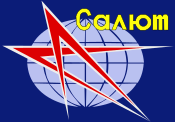Soyuz 16
| Mission type | Test flight forASTP mission |
|---|---|
| Operator | Soviet space program |
| COSPAR ID | 1974-096A |
| SATCATno. | 07561 |
| Mission duration | 5 days 22 hours 23 minutes 35 seconds |
| Orbits completed | 95 |
| Spacecraft properties | |
| Spacecraft | Soyuz 7K-TM No.4 |
| Spacecraft type | Soyuz 7K-TM |
| Manufacturer | NPO Energia |
| Launch mass | 6680 kg[1] |
| Landing mass | 1200 kg |
| Crew | |
| Crew size | 2 |
| Members | Anatoly Filipchenko Nikolai Rukavishnikov |
| Callsign | Буран(Buran- "Blizzard" ) |
| Start of mission | |
| Launch date | 2 December 1974, 09:40:00UTC |
| Rocket | Soyuz-U |
| Launch site | Baikonur,Site 1/5[2] |
| End of mission | |
| Landing date | 8 December 1974, 08:03:35 UTC |
| Landing site | 30 km of the northeast ofArkalyk,Kazakhstan |
| Orbital parameters | |
| Reference system | Geocentric orbit[3] |
| Regime | Low Earth orbit |
| Perigee altitude | 177.0 km |
| Apogee altitude | 223.0 km |
| Inclination | 51.7° |
| Period | 88.4 minutes |
 Salyut program insignia | |
Soyuz 16(Russian:Союз 16,Union 16) was a December, 1974, crewed test flight for a jointSoviet-United Statesspace flightwhich culminated in theApollo–Soyuzmission in July 1975. The two-man Soviet crew,Anatoly FilipchenkoandNikolai Rukavishnikov,tested a docking ring and other systems to be used in the joint flight.
Crew
[edit]| Position | Cosmonaut | |
|---|---|---|
| Commander | Second and last spaceflight | |
| Flight Engineer | Second spaceflight | |
Backup crew
[edit]| Position | Cosmonaut | |
|---|---|---|
| Commander | ||
| Flight Engineer | ||
Reserve crew
[edit]| Position | Cosmonaut | |
|---|---|---|
| Commander | ||
| Flight Engineer | ||
Mission parameters
[edit]- Mass:6,680 kg (14,730 lb)[1]
- Perigee:177.0 km (110.0 mi)[3]
- Apogee:223.0 km (138.6 mi)
- Inclination:51.7°
- Period:88.4 minutes
Background
[edit]The Soyuz 16 mission was the final rehearsal and first crewed mission in a program which culminated in theApollo–Soyuz(ASTP) mission seven months later.[4]TheSoviet Unionand the United States,Cold Warrivals, had signed severalarms controltreaties in the 1960s and 1970s, and had entered into a period ofdetenteby the early 1970s. In 1972, a treaty was signed to participate in a joint crewed space flight as a symbol of this detente.[5]
Early concepts for a joint flight included the docking of aSoyuzcraft to the AmericanSkylabspace station, or anApollo vehicledocking with aSalyutspace station. Once the Americans abandoned their Skylab station in 1974, the Apollo-Salyut concept seemed to be the logical choice, but since the Soviets had started to develop a universal docking adapter for the mission and feared having to publicly reveal details of their military-focused Salyut missions, the two powers opted to link a Soyuz spacecraft with an Apollo spacecraft.[5]
Three test flights of an uncrewed version of theASTPspacecraft were flown:Kosmos 638,launched 3 April 1974;Kosmos 652,launched 15 May 1974; andKosmos 672,launched 12 August 1974. These three flights, and Soyuz 16, were all launched with an improved version of aSoyuz booster.[5]
Mission highlights
[edit]In an unprecedented move, Soviet planners offered to inform theirNASAcounterparts of the time of the launch, as long as they did not reveal that time to the press. NASA officials refused to agree to that condition and, accordingly, were informed of the launch an hour after it occurred, on 2 December 1974.[4]
During the flight,CosmonautsAnatoly FilipchenkoandNikolai Rukavishnikovtested the androgynous docking system to be used for the ASTP mission by retracting and extending a simulated 20 kg American docking ring.[4][5]The crew also tested modified environmental systems, newsolar panelsand improved control systems, as well as a newradardocking system.Air pressurewas reduced from 760 mm to 540 mm andoxygenraised from 20% to 40% to test reducing the planned transfer time to Apollo from two to one hour.[5]On 7 December 1974, the docking ring was jettisoned withexplosive boltsto test emergency measures if the capture latches got stuck during the ASTP flight.
The craft landed 8 December 1974, nearArkalykand was hailed a complete success.[5]The mission duration, six days, matched the ASTP mission duration to within 10 minutes.[4]
References
[edit]- ^ab"Display: Soyuz 16 1974-096A".NASA. 14 May 2020.Retrieved11 October2020.
 This article incorporates text from this source, which is in thepublic domain.
This article incorporates text from this source, which is in thepublic domain.
- ^"Baikonur LC1".Encyclopedia Astronautica. Archived fromthe originalon 15 April 2009.Retrieved4 March2009.
- ^ab"Trajectory: Soyuz 16 1974-096A".NASA. 14 May 2020.Retrieved11 October2020.
 This article incorporates text from this source, which is in thepublic domain.
This article incorporates text from this source, which is in thepublic domain.
- ^abcdClark, Phillip (1988).The Soviet Manned Space Program.New York: Orion Books, a division of Crown Publishers, Inc.ISBN0-517-56954-X.
- ^abcdefNewkirk, Dennis (1990).Almanac of Soviet Manned Space Flight.Houston, Texas: Gulf Publishing Company.ISBN0-87201-848-2.

